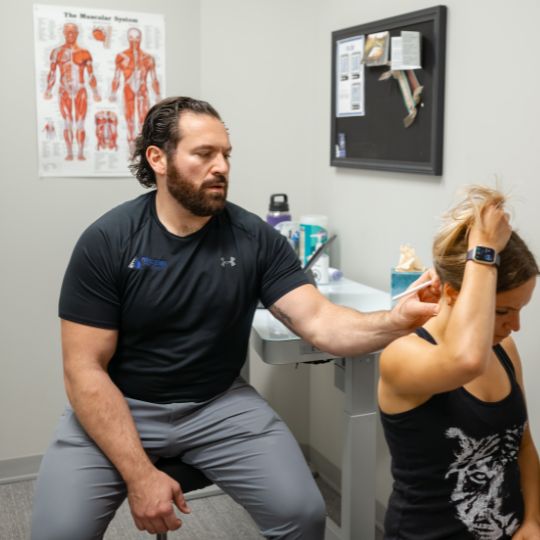Cervical radiculopathy is a common condition that affects the nerves in the neck. It often causes pain, weakness, and numbness that radiates down the arm of the symptomatic side. It is typically caused by compression or irritation of the cervical nerve roots in the cervical spine. Causes can vary and patients can present with a variety of different symptoms. Understanding and managing cervical radiculopathy can often be challenging and complex.
Causes:
Cervical radiculopathy typically stems from the following underlying causes:
- Disc herniations: one of the most common causes is the herniation of intervertebral discs in the cervical spine. When the nucleus pulposus (a gel-like, hydraulic fluid inside the disc) protrudes through the annulus fibrosis (fibrous layered structure surrounding the outside of the disc) and presses against a nerve root, it can result in radiculopathy. As a result, inflammatory chemicals are sent to the area to remove the nuclear material. This unfortunately also causes chemical radiculitis, which makes the nerves more susceptible to compression and irritation.
- Degenerative Disc Disease: As the discs between vertebrae wear down over time, it can lead to narrowing of the spinal canal (stenosis) and compression of nerve roots.
- Bone Spurs: The formation of bony growths on the vertebrae, known as bone spurs, can occur due to aging. These spurs may impinge on nerve roots, causing symptoms of radiculopathy.
- Injury or Trauma: Accidents, falls, or other traumatic events can injure the cervical spine and result in nerve compression.
- Inflammatory Arthritides: Conditions like rheumatoid arthritis or other inflammatory disorders may cause inflammation in the cervical spine, leading to nerve compression.
Symptoms:
The symptoms of cervical radiculopathy can vary but often include:
- Neck Pain: A common symptom, usually localized to the affected side.
- Radiating Pain: Sharp, shooting, and or burning pain that travels down the arm, potentially into the hand and/or fingers.
- Numbness and Tingling: Patients may experience sensations of numbness, tingling, or “pins and needles” in the affected arm.
- Muscle Weakness: Weakness in the muscles of the arm or hand may occur, affecting grip strength and dexterity.
- Loss of Reflexes: Diminished reflexes, particularly in the affected arm, may be observed.
Treatment Options:
Depending on the severity, acuity, and presence or absence of neurological symptoms, treatment of cervical radiculopathy can vary from conservative measures to more invasive treatment options.
-
Conservative Measures:
- In the event of a cervical disc herniation with chemical radiculitis, treatment may include soft tissue manipulation or massage therapy to alleviate tension in the affected musculature.
- End range loading exercises can be used to remodel the disc, alleviating hydraulic pressure on the affected nerve root.
- Peripheral nerve glides can be performed to provide increased neural mobility within the muscles of the affected arm.
- Low intensity, low impact cardiovascular exercise can be utilized to promote blood flow and remove stagnant inflammatory fluids without directly affecting the neck.
-
Medical Interventions:
- Prescription medications: Often times, a medical doctor may prescribe over-the-counter or prescription medications to manage pain and inflammation. Steroids may be used to decrease inflammation whereas muscle relaxers can be prescribed to manage pain and muscle spasms. Anticonvulsants such as gabapentin may be prescribed as well for nerve pain.
- Corticosteroid Injections: Injections of corticosteroids into the affected area can help reduce inflammation and alleviate symptoms.
-
Surgical Options:
- Discectomy: Surgical removal of the herniated disc material to relieve nerve compression.
- Laminectomy/Foraminotomy: Bone spurs and arthritic growth can be removed surgically to alleviate direct pressure on the affected nerve(s).
Conclusion:
Cervical radiculopathy can significantly impact a person’s quality of life, but with early diagnosis and appropriate treatment, many individuals can find relief from their symptoms. Since understanding and managing cervical radiculopathy can be challenging, it is important to triage a patient appropriately. By triaging a patient based on their symptoms they will be able to proceed with the correct course of care, typically the most conservative first and then progress to more invasive measures.





